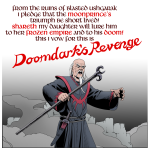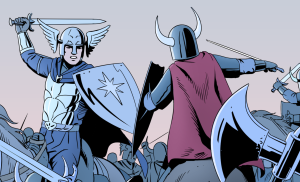 After hastily announcing that I will be releasing Doomdark’s Revenge on the 7th I can now confirm that the actual release date will be the Monday 17th Feb.
After hastily announcing that I will be releasing Doomdark’s Revenge on the 7th I can now confirm that the actual release date will be the Monday 17th Feb.
The main reason for this change is purely logistics. I have to get the website ready to go, PR and Press Packs, Screenshots, Video, submit all versions, and create the store for direct selling.
However, the other reason that I hadn’t taken into account until thinking about submission congestion, is that, during the week of the 17th, it would have been Mike Singleton’s 63rd birthday. So it feels appropriate.
The iOS version is ready to go, and I intend to submit to Apple tonight. Apple usually take 7 days to approve a new submission. If there are any problems, then I would likely miss the 7th. The real area of concern is that from Feb 1st, Apple are insisting that all submissions are done using XCode5 and target iOS7 as the build SDK. In theory this shouldn’t be a problem, however in order to guaranty this, I need to build with the latest version of the Marmalade SDK 7.1.1 and as this version is only BETA at the moment I have slight concerns. I am currently not able to submit to MAC Appstore because of a Marmalade issue, and that affects my confidence in it.
The Android version appears to be ready. The first initial sweep has been done and a few small visual bugs stamped out. The game UI now seems stable across resolutions so I would suspect that supported devices will be the same as with The Lords of Midnight. I don’t foresee any issues moving forward. The turn around time on Google Play is such that I still have plenty of time to fix anything that crops up.
I have done a Blackberry build, and it all seems to be running in the simulator without issue. I need to perform an actual device test but again I don’t foresee any issues. There were some initial problems with the Q10 720×720 resolution but they have been ironed out. BTW: this version will allow the Q10 to rotate and I will include this fix in The Lords of Midnight ASAP.
Samsung and Amazon builds are just packaging. So again, I don’t foresee any issues.
Windows and OSX builds should be good, as this is how I develop. I expect to hand over a master to Fastspring and GoG.com early next week.
The only issue with the OSX version is that it is unlikely to be available in the MAC Appstore for a while. This is due to the aforementioned issue with the Marmalade SDK and OSX Mavericks. If the issue is not fixed soon, and I have a window of opportunity before the 17th ( preferably by the 10th ), I will install an OSX Mountain Lion machine and attempt to build the app. The OSX version will however be available direct or through GoG.com, where I don’t need to release a signed app.
Once the release is out there, I intend to revisit Windows Phone 8 version of both Doomdark’s Revenge and The Lords of Midnight.

